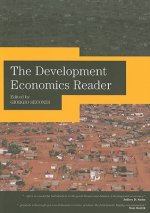
Code: 08030309
Fiscal and Monetary Policies and Problems in Developing Countries
by Eprime Eshag
This book is concerned with the use of fiscal and monetary policies to overcome three major obstacles to development commonly faced by less developed countries: inadequate investment; misallocation of investment resources; and int ... more
- Language:
 English
English - Binding: Hardback
- Number of pages: 309
Publisher: Cambridge University Press
- More about this

51.74 €
Availability:
50/50 We think title might be available. Upon your order we will do our best to get it within 6 weeks.
We think title might be available. Upon your order we will do our best to get it within 6 weeks.We search the world
You might also like
-

Ashes to Ashes
24 € -18 % -

Do-over
44.78 € -

Is He the Man? ... a New Edition.
28.74 € -18 % -

Then The Stillness
25.71 € -18 % -

Prologue to Conflict
19.96 € -12 % -

Prince & The Dancing Girl
21.68 € -19 %
Give this book as a present today
- Order book and choose Gift Order.
- We will send you book gift voucher at once. You can give it out to anyone.
- Book will be send to donee, nothing more to care about.
Availability alert
Enter your e-mail address and once book will be available,
we will send you a message. It's that simple.
More about Fiscal and Monetary Policies and Problems in Developing Countries
You get 130 loyalty points
 Book synopsis
Book synopsis
This book is concerned with the use of fiscal and monetary policies to overcome three major obstacles to development commonly faced by less developed countries: inadequate investment; misallocation of investment resources; and internal and external imbalances i.e. inflation and balance of payments deficits. The book is divided into six chapters the first two of which are devoted to the definition of concepts and to an explanation of the Keynesian model of income determination and of Kalecki's model of financing investment, within the framework of which the role of fiscal and monetary measures and of foreign capital is later examined. Chapters 3 and 4 discuss the role of fiscal measures and of foreign capital, respectively, in promoting domestic investment. Chapter 5 examines the use of both fiscal and monetary instruments, including industrial and agricultural development banks, to influence the pattern of investment. The last chapter is devoted to the problems of internal and external imbalances. The author examines policies pursued by a representative sample of developing countries and concludes that most of them fail adequately to exploit the potential of fiscal and monetary instruments and of foreign capital to overcome the three sets of obstacles to development largely bacause of institutonal (socio-political) constraints. The approach to inflation and balance of payments difficulties followed in the book differs significantly from that of monetarists, notably the Chicago school and the IMF, whose basic propositions are reviewed and critically examined in some detail in Chapters 2 and 6. Although the primary focus of the book is on developing economies, this part of it is also relevant to industrial countries.
 Book details
Book details
Book category Books in English Economics, finance, business & management Economics Development economics & emerging economies
51.74 €
- Full title: Fiscal and Monetary Policies and Problems in Developing Countries
- Author: Eprime Eshag
- Language:
 English
English - Binding: Hardback
- Number of pages: 309
- EAN: 9780521249003
- ISBN: 9780521249003
- ID: 08030309
- Publisher: Cambridge University Press
- Weight: 516 g
- Dimensions: 216 × 138 mm
Trending among others
-

Agile Extension to the BABOK(R) Guide
36.71 € -19 % -

Ecology of Wisdom
12.20 € -22 % -

Banker to the Poor
16.03 € -23 % -

Poor Economics
14.72 € -26 % -

How to Spend $50 Billion to Make the World a Better Place
22.49 € -1 % -

Shaping the Future of the Fourth Industrial Revolution
20.06 € -14 % -

Prosperity Paradox
20.27 € -28 % -

Start Something That Matters
13.31 € -20 % -

Reinventing the Organization
26.42 € -19 % -

Factfulness Illustrated
24.81 € -20 % -

Methods to Analyse Agricultural Commodity Price Volatility
222.63 € -

Next Convergence
16.23 € -22 % -

Age of Sustainable Development
38.73 € -14 % -

Living Standards and the Wealth of Nations
13.41 € -

Economic Development
108.23 € -

End of Poverty
18.75 € -6 % -

Introduction to Sustainable Development
63.84 € -4 % -

Brand Premium
28.34 € -4 % -

Introduction to Modern Economic Growth
63.74 € -16 % -

Getting Better
24.60 € -

Modern Evolutionary Economics
39.84 € -

Dubai
33.38 € -4 % -

Finance and Sustainable Development
34.59 € -

History of Development
32.37 € -

WTF?
30.35 € -9 % -

Development Economics Reader
112.67 € -

China's Resource Diplomacy in Africa
121.04 € -

Resurgent Asia
62.94 € -

Institutional Barriers in the Transition to Market
121.04 € -

Foreign Aid, War, and Economic Development
45.89 € -

Transitions to Sustainable Development
200.53 € -

Technological Innovation and Economic Development in Modern Japan
62.43 € -

Impact Evaluation in Practice
43.87 € -

New Paradigm for Korea's Economic Development
121.04 € -

New Paradigm for Korea's Economic Development
121.04 € -

War and Economic Development
45.89 € -

Zimbabwe's Casino Economy. Extraordinary Measures for Extraordinary Challenges
50.23 € -

Poland From Partitions to EU Accession
142.83 € -

Jeffrey Sachs
18.45 € -4 % -

ISO 50001 Energy Management Systems
18.65 € -18 % -

Wall Street
25.71 € -18 % -

Economics of Strategy
72.52 € -

BRICS
117.31 € -

Capitalism with Chinese Characteristics
32.77 € -19 % -

Green Capitalism. The God that Failed
28.13 € -

Performance Economy
153.63 € -

SDGs Amidst Multiple Global Shocks
189.74 € -

Why Perestroika Failed
288.90 € -

The Self-Deception Trap
45.59 €
Collection points Bratislava a 2642 dalších
Copyright ©2008-24 najlacnejsie-knihy.sk All rights reservedPrivacyCookies


 15549 collection points
15549 collection points Delivery 2.99 €
Delivery 2.99 € 02/210 210 99 (8-15.30h)
02/210 210 99 (8-15.30h)